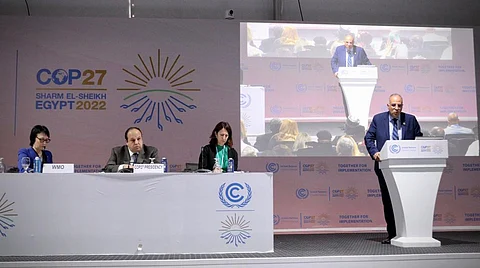

World leaders at the 27th Conference of Parties (COP27) to the United Nations Framework Convention on Climate Change launched a water adaptation and resilience action plan November 14, 2022. The initiative will have an Africa-first focus, giving hope to drought-ravaged populations, especially in the Horn of Africa.
The action plan, Action on Water Adaptation or Resilience (AWARe), aims to foster political efforts in establishing pan-African water hubs.
AWARe will address water security as part of climate change adaptation and will focus on three priorities: Decrease water losses worldwide and improve water supply; propose and support implementing policies for cooperative water-related adaptation action and cooperation and interlinkages between water and climate action.
The plan would go a long way in the mitigation efforts, said the head of the COP27 Presidency Sameh Shoukry.
“As we design and implement adaptation solutions, management of water sources must prominently feature in the discussions and actions. Water is vital in sustaining lives and livelihoods,” he said.
The initiative would bring stakeholders together “to minimise the challenges that trouble the world’s vulnerable communities and ecosystems,” he added.
The multisectoral initiative was a result of collaboration between various stakeholders, including the African Union (AU), Water and Climate Coalition Leaders, the World Meteorological Organization (WMO) and the African Ministers’ Council on Water (AMCOW), among others.
Over the past 20 years, water-related hazards have consistently increased in frequency and intensity, with at least 1.6 billion people affected by floods and 1.4 billion by droughts, according to a World Bank report of 2021.
“Weather, climate or water-related disaster has occurred on average every single day within the past 50 years (1970-2019), taking the lives of 115 people daily and causing US$ 202 million in daily losses,” said a study carried out by WMO a year ago.
Global water crisis affects billions worldwide daily, so the action plan is timely, said Egypt’s minister for Water Systems Hani Sewilam.
“The AWARe initiative will catalyse cooperation to address water as a key to adaptation and its co-benefits, as well as enhanced resilience,” he said.
One of the critical goals of the initiative is to ensure there is 50 per cent less damage from floods and droughts by 2030, even as reality paints a grim picture of the current situation.
Early warning systems do not cover a third of the world’s population, doubling the risk of the number of individuals exposed to floods and droughts due to climate change, according to the Intergovernmental Panel on Climate Change (IPCC).
There’s an urgent need for the action plan as almost three-fourths of natural disasters are water-related, said WMO Deputy Secretary-General Elena Manaenkov.
The action plan has six comprehensive data-driven solutions it recommends regional blocks or heads of governments to put in place to enable a quick transition from awareness to action.
The solutions described include a set of global water information services like accurate hydrological data to help understand the scarcity and availability of water per region. It also has a water and climate stock take that integrates water and climate-related databases to inform decision-making.
A cryosphere information mechanism that details data on frozen water parts of the earth, like waters that surround Antarctica and the Arctic and a new financing rationale focusing on areas of priority is also a part of it
Last but not least, a need for local engagements on how to implement climate-resilient investments on the ground at different government levels and a need for regional cooperation is necessary for shared early warning systems to reduce the impact of loss.
The plan calls for concerted efforts to stop pollution, manage wastewater and restore or preserve water towers and catchment areas, including glaciers and snow that are melting away, impacting sources of streams and rivers.
Several victims from affected communities in East Africa have welcomed the move, including smallholder farmers and pastoralists. “Early warning systems should be effective, with timely news of impending droughts and other water-related hazards communicated so that we are not caught unawares like usual,” said farmer John Njuguna.
Women bear the biggest brunt of climate change and water scarcity, said Kenya’s Minister for Environment Soipan Tuya. “Women get disproportionately affected and should now get opportunities to play critical roles in climate action by equipping them,” she said.
The multipronged initiative aims to build resilience and adaptive capacity at a time scientists warn that the frequency and severity of extreme weather events are expected to keep increasing.